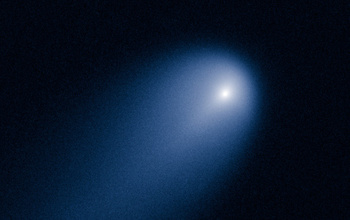News Release 13-183
Picture perfect
Catching the tail of Comet ISON
October 29, 2013
This material is available primarily for archival purposes. Telephone numbers or other contact information may be out of date; please see current contact information at media contacts.
While comets have been blamed for spawning plagues, assassinations, red rains, war failures and even births of two-headed animals, these small astral bodies most likely are harmless dirty balls of ice that pay our orbit a visit once in a while.
This year, Comet ISON may become one of the most picturesque night-time views in decades, making it perfect subject matter for astro-photography buffs worldwide. That's why the National Science Foundation (NSF) and Astronomy Magazine have teamed up to celebrate Comet ISON's arrival and are sponsoring a photography contest from October through mid-January.
So far, Comet ISON has only been visible by telescope, but soon it should be viewable with binoculars and ultlimately with the naked eye from dark locations with low levels of light pollution. According to Astronomy Magazine, on Dec. 8, Comet ISON crosses into the northern sky, where it should shine brighter than 1st magnitude and perhaps sport a spectacular tail. The magazine's editors predict Northern Hemisphere viewers will get increasingly better views as the December holiday season approaches.
Amateur and professional photographers worldwide can submit images online at NSF's Comet ISON photo contest page through Jan. 15, 2014. The contest is divided into three categories:
- Cameras and tripods without the use of tracking or telescopes
- Piggyback cameras riding atop a telescope or motorized mount
- Through-the-scope images where the telescope acts as the camera's lens.
First prize in each category is $2,500. Second prize is $1,000. In addition to the six prize winners, website visitors will choose an additional "People's Choice" award worth $1,500.
Winners will be notified before the public announcement is made in April 2014. Winning images will appear in print and online in Astronomy Magazine, Discover magazine, and on the NSF website.
For more information, visit NSF's Comet ISON photo contest page.-NSF-
Media Contacts
Ivy F Kupec, NSF, (703) 292-8796, email: ikupec@nsf.gov
The U.S. National Science Foundation propels the nation forward by advancing fundamental research in all fields of science and engineering. NSF supports research and people by providing facilities, instruments and funding to support their ingenuity and sustain the U.S. as a global leader in research and innovation. With a fiscal year 2023 budget of $9.5 billion, NSF funds reach all 50 states through grants to nearly 2,000 colleges, universities and institutions. Each year, NSF receives more than 40,000 competitive proposals and makes about 11,000 new awards. Those awards include support for cooperative research with industry, Arctic and Antarctic research and operations, and U.S. participation in international scientific efforts.
Connect with us online
NSF website: nsf.gov
NSF News: nsf.gov/news
For News Media: nsf.gov/news/newsroom
Statistics: nsf.gov/statistics/
Awards database: nsf.gov/awardsearch/
Follow us on social
Twitter: twitter.com/NSF
Facebook: facebook.com/US.NSF
Instagram: instagram.com/nsfgov

